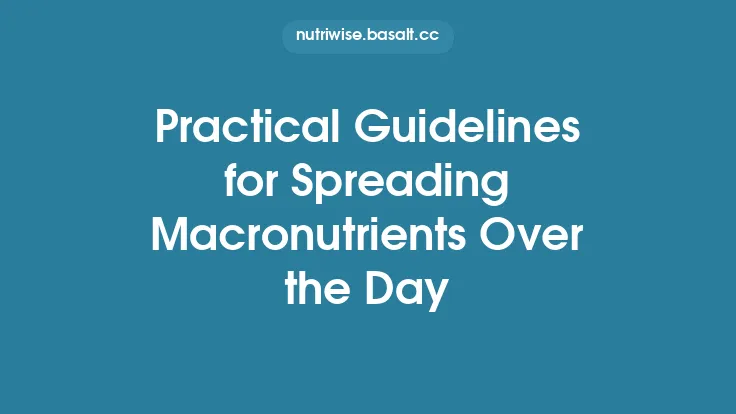When it comes to hitting your calorie goals consistently, the biggest obstacle is often not the lack of willpower but the lack of a clear, visual system that tells you exactly how much you should be eating each day. A printable portion‑control planner bridges that gap by turning abstract numbers into concrete, bite‑sized actions you can see, fill in, and reference at a glance. Below is a comprehensive guide to creating, using, and mastering such a planner so that your weekly meals stay aligned with your calorie targets—without the guesswork.
Understanding Calorie Goals and Portion Control
Why calories matter
Calories are the unit of energy that fuels every bodily function, from breathing to sprinting. When you consume more calories than your body expends, the excess is stored as fat; when you consume fewer, you tap into those stores for energy, leading to weight loss. Consistency is key—daily fluctuations of a few hundred calories can stall progress, while steady adherence to a target range promotes predictable results.
Portion control as the practical tool
Portion control translates calorie targets into real‑world food amounts. Instead of “eat less,” you get “eat 150 g of chicken breast (≈165 kcal) and 1 cup of broccoli (≈55 kcal).” By pairing each food item with its calorie contribution, you can build meals that add up precisely to your daily goal.
Design Elements of a Printable Portion‑Control Planner
A well‑structured planner should be intuitive enough that you can fill it out in a few minutes each evening. Below are the core components to include:
| Section | Description |
|---|---|
| Day Header | Columns for Monday through Sunday, each with a bold date field. |
| Meal Slots | Separate rows for Breakfast, Lunch, Dinner, and up to three Snacks. |
| Food Item Column | Space to write the specific food (e.g., “Greek yogurt, plain”). |
| Portion Size Column | Record the measured amount (e.g., “¾ cup” or “120 g”). |
| Calories per Portion Column | Pre‑filled with standard values (e.g., “100 kcal per 100 g”). |
| Total Calories per Meal | Formula‑ready cell that multiplies portion size by calories per portion. |
| Daily Calorie Target | A highlighted box at the top of each day showing your personal goal (e.g., 1,800 kcal). |
| Actual Daily Total | Summation of all meal totals, automatically calculated if you use a fillable PDF. |
| Variance | Difference between target and actual (positive = under, negative = over). |
| Notes / Adjustments | Free‑form area for observations like “felt hungry after lunch” or “added extra veggies.” |
Layout tips
- Paper size: A4 or Letter works best; design the planner in landscape orientation to fit all columns on one page.
- Margins: Keep a 0.5‑inch margin to avoid printer cut‑offs.
- Font choice: Use a clean sans‑serif (e.g., Arial, Calibri) at 10‑12 pt for readability.
- Fillable fields: If you’re comfortable with PDF editing tools, embed form fields so the calculator works automatically; otherwise, a simple printed grid works just as well.
How to Calculate Your Personal Daily Calorie Target
Before you can fill the planner, you need a reliable calorie target. The most common method combines Basal Metabolic Rate (BMR) with an Activity Factor.
- Calculate BMR
- Mifflin‑St Jeor Equation (considered the most accurate for most adults):
- For men:
\[
\text{BMR} = (10 \times \text{weight}{\text{kg}}) + (6.25 \times \text{height}{\text{cm}}) - (5 \times \text{age}) + 5
\]
- For women:
\[
\text{BMR} = (10 \times \text{weight}{\text{kg}}) + (6.25 \times \text{height}{\text{cm}}) - (5 \times \text{age}) - 161
\]
- Apply an Activity Factor
| Activity Level | Factor |
|---|---|
| Sedentary (little or no exercise) | 1.2 |
| Lightly active (light exercise 1‑3 days/week) | 1.375 |
| Moderately active (moderate exercise 3‑5 days/week) | 1.55 |
| Very active (hard exercise 6‑7 days/week) | 1.725 |
| Extra active (very hard daily training or physical job) | 1.9 |
\[
\text{Total Daily Energy Expenditure (TDEE)} = \text{BMR} \times \text{Activity Factor}
\]
- Set the Goal
- Weight maintenance: Use TDEE as your target.
- Weight loss: Subtract 250‑500 kcal from TDEE for a safe 0.5‑1 lb/week deficit.
- Weight gain: Add 250‑500 kcal for a gradual increase.
Example
A 30‑year‑old woman, 65 kg, 165 cm, lightly active:
- BMR = (10 × 65) + (6.25 × 165) – (5 × 30) – 161 = 650 + 1031.25 – 150 – 161 = 1,370 kcal
- TDEE = 1,370 × 1.375 ≈ 1,884 kcal
- Goal for modest loss = 1,884 – 400 ≈ 1,484 kcal (round to 1,500 kcal for simplicity).
Enter “1,500 kcal” in the Daily Calorie Target box for each day of the week.
Setting Up the Planner for the Week
- Pre‑populate common foods
List staple items you use regularly (e.g., “brown rice, cooked,” “skinless chicken breast,” “olive oil”) with their standard calorie per portion values. This reduces the need to look up numbers each day.
- Allocate calories by meal
Decide how you want to split your daily target. A common split is:
- Breakfast: 20%
- Lunch: 30%
- Dinner: 30%
- Snacks (combined): 20%
For a 1,500 kcal target, that translates to 300 kcal for breakfast, 450 kcal each for lunch and dinner, and 300 kcal for snacks.
- Draft a rough menu
Write down the main dish for each meal, then fill in side items and snacks, ensuring the summed calories stay within the allocated bucket.
- Finalize portions
Convert the calorie budget into gram or volume measurements using the “Calories per Portion” column. For example, if 150 kcal is allocated for a protein source that provides 165 kcal per 100 g, you would record a portion of ~91 g (150 ÷ 1.65).
- Review the variance column
After you’ve entered all meals, check the “Actual Daily Total.” If you’re over by more than 5‑10 % (≈150 kcal for a 1,500 kcal plan), adjust snack sizes or swap a higher‑calorie item for a lower‑calorie alternative.
Portion‑Size Reference Guides to Include
A printable planner is only as useful as the reference data it carries. Consider attaching a one‑page cheat sheet that lists:
- Standard serving sizes (e.g., 1 cup cooked grains = 150 g, 1 medium apple = 182 g).
- Visual cues (e.g., a deck of cards ≈ 3 oz of meat, a fist ≈ 1 cup of vegetables).
- Calorie density categories (low < 0.5 kcal/g, medium 0.5‑1.5 kcal/g, high > 1.5 kcal/g) to help you estimate portions when exact measurements aren’t possible.
- Common cooking fats (1 tsp oil = 40 kcal, 1 tbsp butter = 100 kcal).
Print this reference on the back of the planner or keep it as a separate sheet for quick lookup.
Tips for Accurate Food Measurement
- Invest in a digital kitchen scale – Weighing raw ingredients gives the most precise calorie count.
- Use measuring cups and spoons for liquids – A 250 ml cup is a reliable benchmark for water, broth, and low‑viscosity sauces.
- Read nutrition labels carefully – Pay attention to the serving size listed; if you consume 1.5 servings, multiply the calories accordingly.
- Account for cooking losses/gains – Grilled chicken loses ~10 % weight through water loss; adjust the final weight accordingly when logging.
- Batch‑cook and portion out – Cook a large batch of a staple (e.g., quinoa) and divide it into pre‑weighed containers; this eliminates daily weighing.
Tracking and Adjusting Your Intake
Even the best‑designed planner benefits from periodic review:
- Weekly review – At the end of each week, tally the total variance. A consistent negative variance (under‑eating) may signal that your target is too low or that you’re under‑fueling, which can affect energy and metabolism.
- Mid‑month recalculation – If you’ve lost or gained more than 2 % of your body weight, recalculate BMR and adjust the daily target accordingly.
- Meal‑specific notes – Use the “Notes” column to record satiety levels (“still hungry after lunch”) or performance cues (“energy dip at 3 pm”). Over time, patterns emerge that help you fine‑tune portion sizes without sacrificing satisfaction.
Maintaining Consistency Over Time
Consistency is reinforced by habit loops:
- Cue – Place the printed planner on your fridge or kitchen counter where you see it each morning.
- Routine – Fill out the day’s meals the night before, using the planner as a checklist.
- Reward – Celebrate hitting your daily target with a non‑food reward (e.g., a short walk, a favorite podcast episode).
By linking the planner to a visual cue and a small reward, you embed the behavior into your daily rhythm.
Common Pitfalls and How to Avoid Them
| Pitfall | Why it Happens | Solution |
|---|---|---|
| Relying on “eyeball” portions | Habitual under‑estimation of calorie‑dense foods. | Use the scale for at least the first two weeks; then transition to visual cues. |
| Forgetting to log condiments | Sauces and dressings add hidden calories. | Keep a separate “Condiment Log” column for items like ketchup, soy sauce, or salad dressing. |
| Over‑filling snack slots | Snacks are easy to over‑consume when not measured. | Pre‑portion snacks into zip‑lock bags or containers; log the exact bag you eat. |
| Ignoring day‑to‑day variation | Some days you’re more active, others less. | Adjust the daily target by ±5‑10 % based on activity logs; the planner can include a “Adjusted Target” row. |
| Skipping the variance check | Small daily overshoots accumulate. | Make it a habit to glance at the variance column before bed; correct tomorrow’s portions if needed. |
Adapting the Planner for Special Dietary Needs
While the core structure stays the same, you can tailor the planner for:
- High‑protein regimens – Add a “Protein (g)” column next to each food item; sum the daily total to ensure you meet your target (e.g., 1.6 g/kg body weight).
- Low‑carb approaches – Include a “Net Carbs (g)” column; keep daily carbs under a set limit (e.g., 50 g).
- Vegetarian or vegan diets – Populate the staple list with plant‑based proteins (tofu, tempeh, legumes) and ensure you have a reliable calorie per portion reference for each.
- Medical restrictions – If you need to limit sodium or sugar, add dedicated columns for those nutrients and track them alongside calories.
The flexibility of a printable format means you can simply add or remove columns without redesigning the entire sheet.
Printing and Practical Use Tips
- Choose the right paper – A slightly heavier 80‑100 gsm paper reduces bleed‑through when you use pens or markers.
- Print double‑sided – Use the front for the weekly grid and the back for the portion‑size cheat sheet; this saves space and keeps everything together.
- Use a pen with fine tip – A 0.5 mm ballpoint or gel pen provides clear, legible numbers without smudging.
- Laminate for reusability – If you prefer a reusable sheet, laminate the planner and use dry‑erase markers; just keep a separate sheet for the cheat sheet.
- Create a “starter pack” – Print a set of 4‑6 planners at once and keep them in a binder; rotate them weekly to avoid wear and tear.
Integrating the Planner with Other Health Tools (Without Overlap)
Even though this article focuses on a printable planner, you can still benefit from complementary, non‑redundant tools:
- Fitness trackers – Sync your step count or active minutes to gauge whether you need to adjust your calorie target for a particularly active week.
- Hydration logs – Keep a simple water‑intake column on the side; adequate hydration supports satiety and metabolic function.
- Sleep journals – Note sleep quality; poor sleep can affect hunger hormones, prompting you to revisit portion sizes.
These integrations add context without duplicating the macro‑tracking or grocery‑list functions covered in other templates.
By constructing a printable portion‑control planner that aligns each food item with its calorie contribution, you transform abstract nutrition goals into a concrete, visual roadmap. The planner’s weekly layout, built‑in calculations, and accompanying reference guides empower you to make precise, consistent choices—whether you’re aiming for weight loss, maintenance, or simply a more mindful relationship with food. Print it, fill it out, and let the clarity of numbers guide you toward your calorie goals, one portion at a time.




